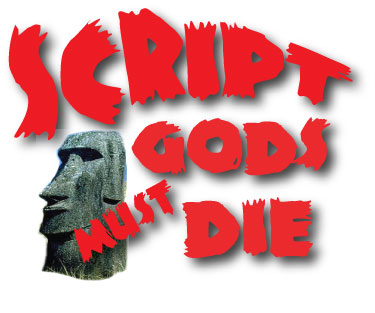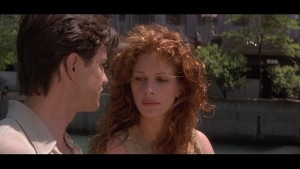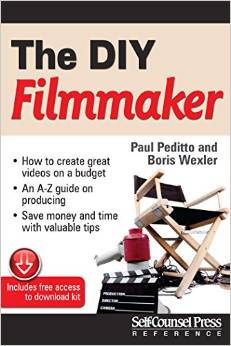Last night teaching at Chicago Filmmakers we were looking over a script loaded with action line verbs like she realizes and he thinks, which, of course, triggered the Unfilmables debate. It always does.
The student pointed out several professional screenplays that broke the rules. Being a rule breaker from way back, I was aware of each of these exceptional scripts. So today, in the spirit of learning the rule so you can break it, let’s venture onto the subject of Unfilmables and Action Line POV.
The rule we’re discussing is: Action lines = What the camera is seeing now. Who is in the shot and what is happening. That is all that goes into action lines. Period!
Good luck enforcing that.
Pros cheat all the time, as evidenced by this excellent rant from Go Into The Story: “A quick aside about so-called ‘unfilmables’: Here’s my deal: There should be NO debates anymore. Ever. The idea that we can’t write what actors can’t act or what someone in a movie theater can’t see is completely wrong. I just taught a semester-long course called “The History of American Screenwriting” and part of that research involved tracking script evolution since the 1890s. I found so-called ‘unfilmables’ stretching back to the silent era. For decades screenwriters have done whatever they could to tell stories the best way they can and this extends to what I call ‘editorializing’ in scene description, commenting on the atmosphere of the moment, or the inner feelings of a character, and on and on and on. Yes, we have to be judicious — a screenplay is not a novel after all — but can we once and for all lay to rest this crazy idea that there are certain things we can not write in a screenplay. It’s proven wrong over and over in contemporary screenplays, and so-called ‘unfilmables’ have been in use for almost the entire time there have been formalized screenplays.”
I’ve written about this before for Script Magazine. Screenplays are mostly dialogue and action. Master both, you’ll be a writer they won’t be able to ignore. Writing dialogue is an art but what’s often ignored is that action line writing is just as much an exercise in originality. It’s not enough to just write action lines as what the camera is seeing now. Not enough by half. The rest of the equation is: Action lines = What the camera is seeing now-with attitude. Meaning your POV, your voice, your attitude filtering into the action lines. Need an example?
Here’s one from Backdraft:
INT. ELEVATED TRAIN – MORNING
A pissed-off Chicago, hauling itself off to work in the morning snap, passes by Brian’s window. Tough Midwestern brick. Tough Midwesterners. Heads-down in their 150 year war with a wind committed to pushing the whole damn thing into Lake Michigan.
What a marvel that little paragraph is! Anyone living in Chicago–especially those of us who take the EL every day—can attest to the truth in that passage. If you were just following the KISS (keep it simple, stupid) approach, you would write something like: Brian rides a grimy subway car. There is nothing wrong with this. Describes what the camera sees. Problem is, anyone can write Brian rides a grimy subway car. Now look at the above example. Look how the writer puts you into the head of the protagonist. This is POV. It is advanced screenwriting. It’s what separates the pro from everyone else. Do you think the fact that you can’t see “their 150 year war with wind” is going to be penalized by the reader at that prodco/screenplay contest/agency? Hell no. Those eyes are starved for originality. The pro gives it to them with POV.
What the camera sees now—with attitude. Does that mean chuck all rules and go into the head of the character EVERY time. Hell no.
Check out a recent student sample:
Edna kisses her husband, making sure he’s OK. When she realizes he doesn’t need any help she goes downstairs to put all the clothes in the laundry.
The camera can’t see “she realizes.” But you just said….! You could argue it’s essentially the same rule breaking but for me this is a very different example. In the Backdraft script we’re defining an entire world, and the POV for our lead character–in three lines! My student’s example? It adds nothing to character. It also shows a fundamental lack of understanding about what action lines are supposed to accomplish. Sure, pros cheat. They do it all the time. But they have the chops to pull it off. Do you?
Here’s another script that blew me away. Amazingly, it’s My Best Friend’s Wedding. Check out this passage:
A guy comes over. Could be 40, successful, a broker's pin-stripe. Nearly as attractive as he thinks he is. GUY Know what you're looking for, little lady? Little lady, huh? She glances at his coven of buddies, who pretend not to notice. Then, straight to the guy's blue eyes. JULIANNE Yeah. Do you? GUY I asked first. Ah. Wit. She holds up her cigar... JULIANNE I like 'em long and hard. Kind of... big around.
Whoa…we go right into Julia Roberts’ head! Wait a minute, Peditto…you’re giving contradictory information! You just said it has to be…
It has to be kick-ass writing. Period. It has to add to character or plot. It has to be essential, timely, not excessive. Ron Bass is a pro, good enough to write this well for even a romcom (sorry romcom lovers, not a fan) Here’s one more example, same script:
... CRASH into a chest-high metal stand that displays animal facts. We have followed him as she is WIPED from frame. His face from shock... to amusement. MICHAEL Now, there's my girl. ... to tenderness. PAN back to see her wearing everything from her cardboard container. Nachos, fudge sauce, Diet Coke, the works. It is really awful. Kids, bystanders, laughing cruelly. Her eyes fill with tears, and she tries bravely to smile against it... JULIANNE See, I can only do it with beer. He takes out his handkerchief. And with that and his hands, gently scoops the worst of the mess off her. The fact that he's touching her breasts and her body is something they pretend not to notice. She laughs softly, and a few tears fall, even though she doesn't know why. Such an odd, raw, confusing moment. To the world looking on, they are lovers. MICHAEL (murmurs) See, better already. And he kisses her face. Not quite her lips. But only an inch away. We can feel her heart pounding. He strips off his shirt, only a tank top underneath. We can hear her heart pounding?! Whaaaaaat?! What freaking camera can see that? You can cheat this stuff, that's my point. But you'd best pick your spots or your page count will balloon. And you'd best be consistent...if we're going into Julia Roberts' mind, we need to do it from page 1 until page 101. OK?




